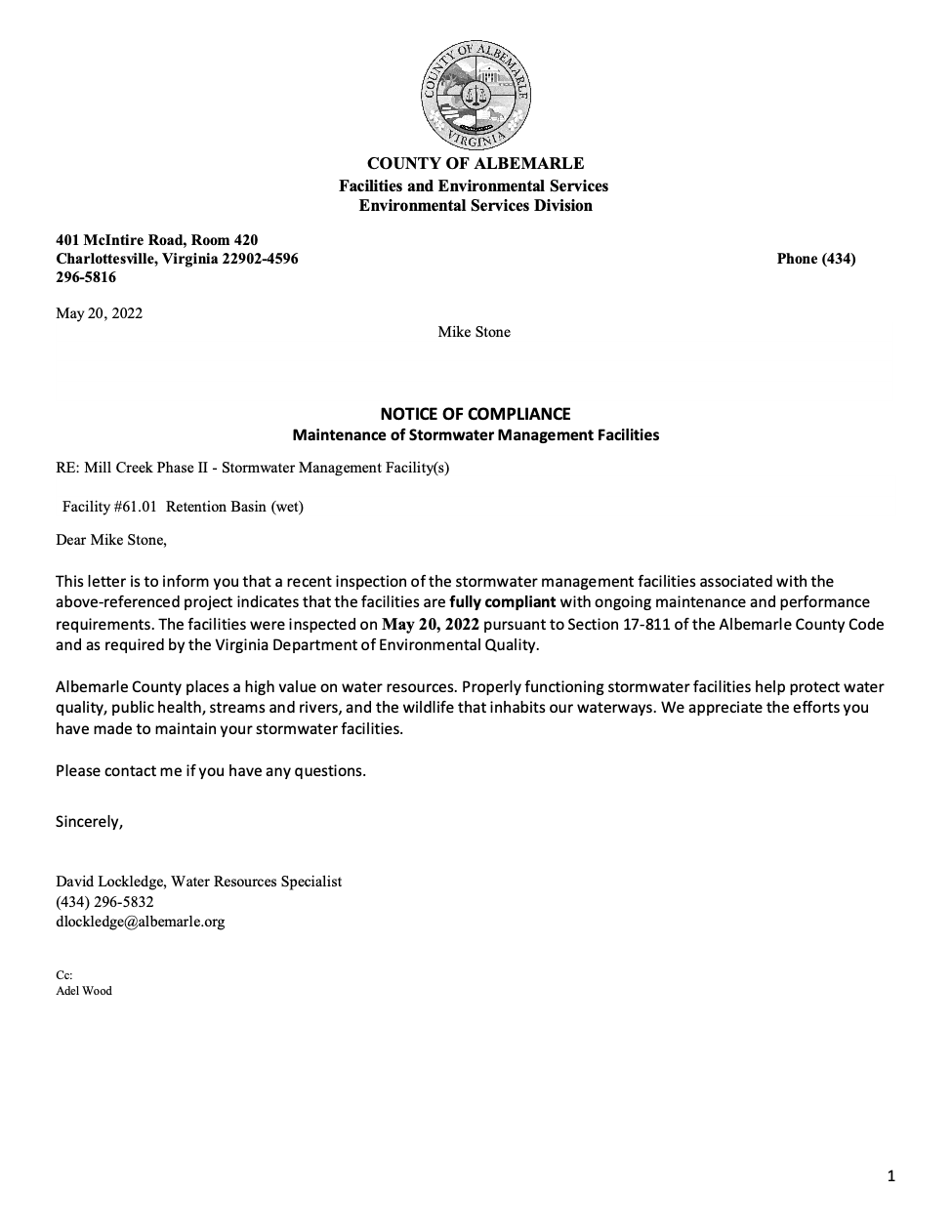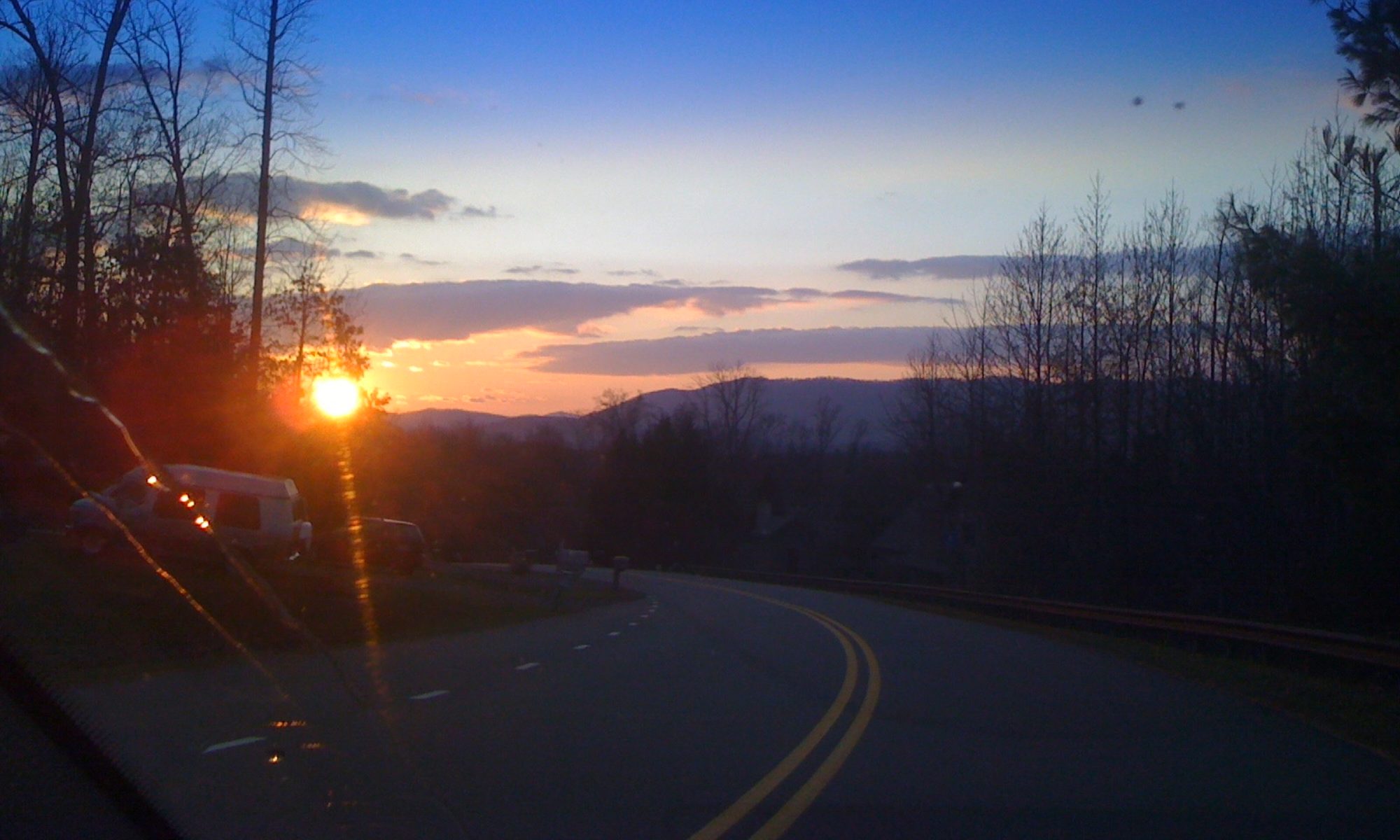STAGE I
November 2021
In late November 2021, we asked an Albemarle County official to speak with us about the erosion of the steep pond banks from invasive plants. He turned out to be our inspector for the pond and started to educate us on what we needed to know about our MCS wet pond. The pond is essential in that it controls the water flow from MCS onto Lake Reynovia. The pond has a dam. There is a riser pipe with a channel under the dam to control normal drainage and a spillway that acts as a backup should the dam begin to overflow. The riser pipe is also the primary spillway in case of an extreme event.
The MCS board asked committee member Adele Wood to look into what needed to be done to bring our retention pond into compliance with County regulations. She solicited Michael Wheelwright, Grounds Chair MCS 2005 to 2017 for past information about the pond and David Lockledge our county inspector to advise us. They told us that timely pond maintenance is the most important maintenance to avert catastrophic costs. With Michael’s vast knowledge and prompting, the MCS General Grounds Management Plan was created. David pointed out the pond’s design structures and sent us an inspection report explaining what needed to be fixed. Without them, we would not have known to do the pond maintenance that saved the dam.


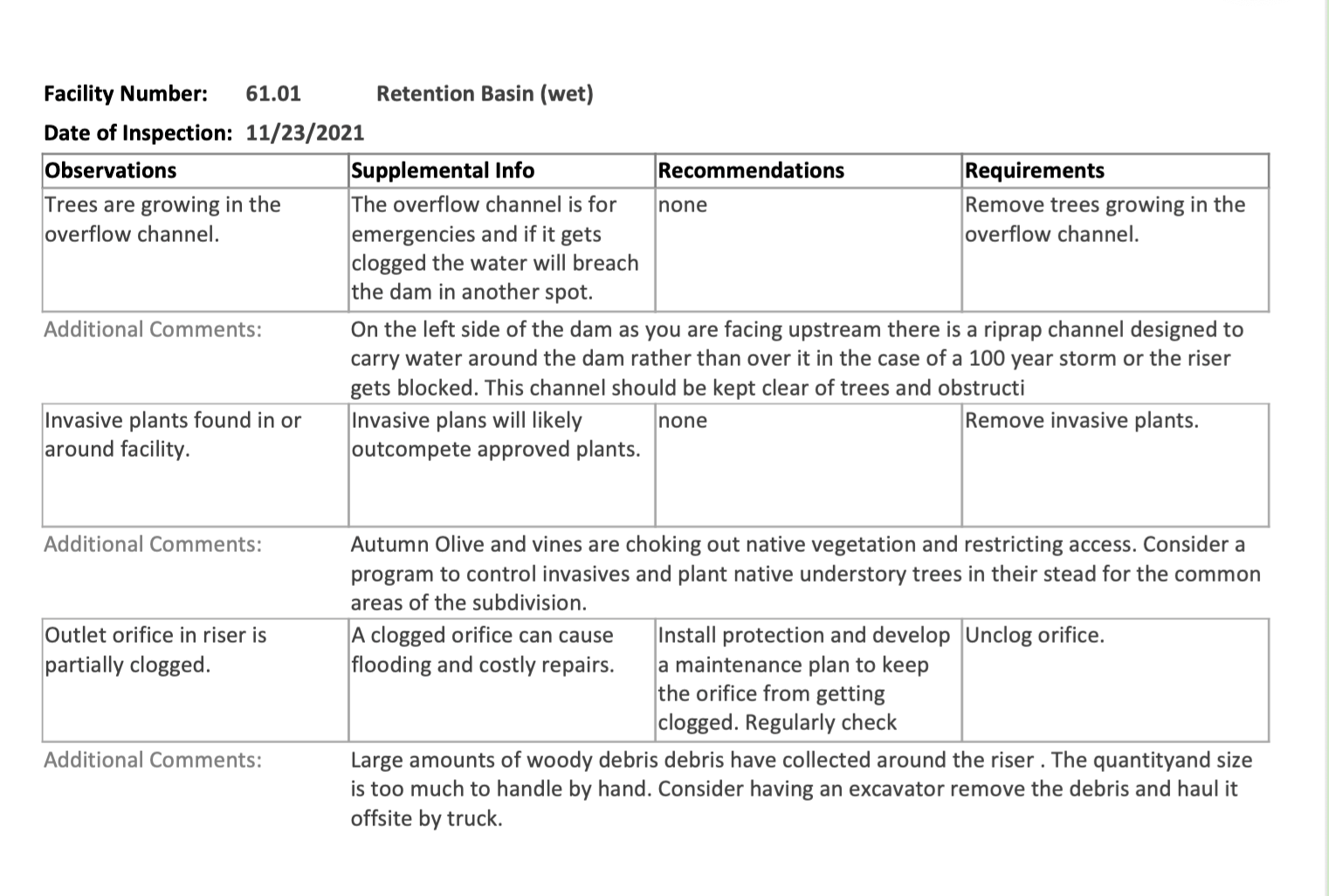
Spring of 2022
Spring of 2022 With advice from experts in the field and former grounds chair Michael Wheelwright. “The Mill Creek South General Grounds Management Plan” was being written. In April this plan, including Important Pond Maintenance of the pond that catches all Mill Creek South stormwater runoff was finished and available. Additionally, our county inspector continued to help us understand the Wet Retention Pond, its parts, and what professional maintenance jobs we needed to hire to get storm ready. Four expert contractors were contacted and asked to bid on the project.
- The riser pipe with trash rack, and the pond area surrounding it needed to be cleared of debris.
- The emergency spillway channel needed to be cleared of blocking trees and brush.
- An island with a tree had formed at the mouth of the spillway channel and needed to be removed.
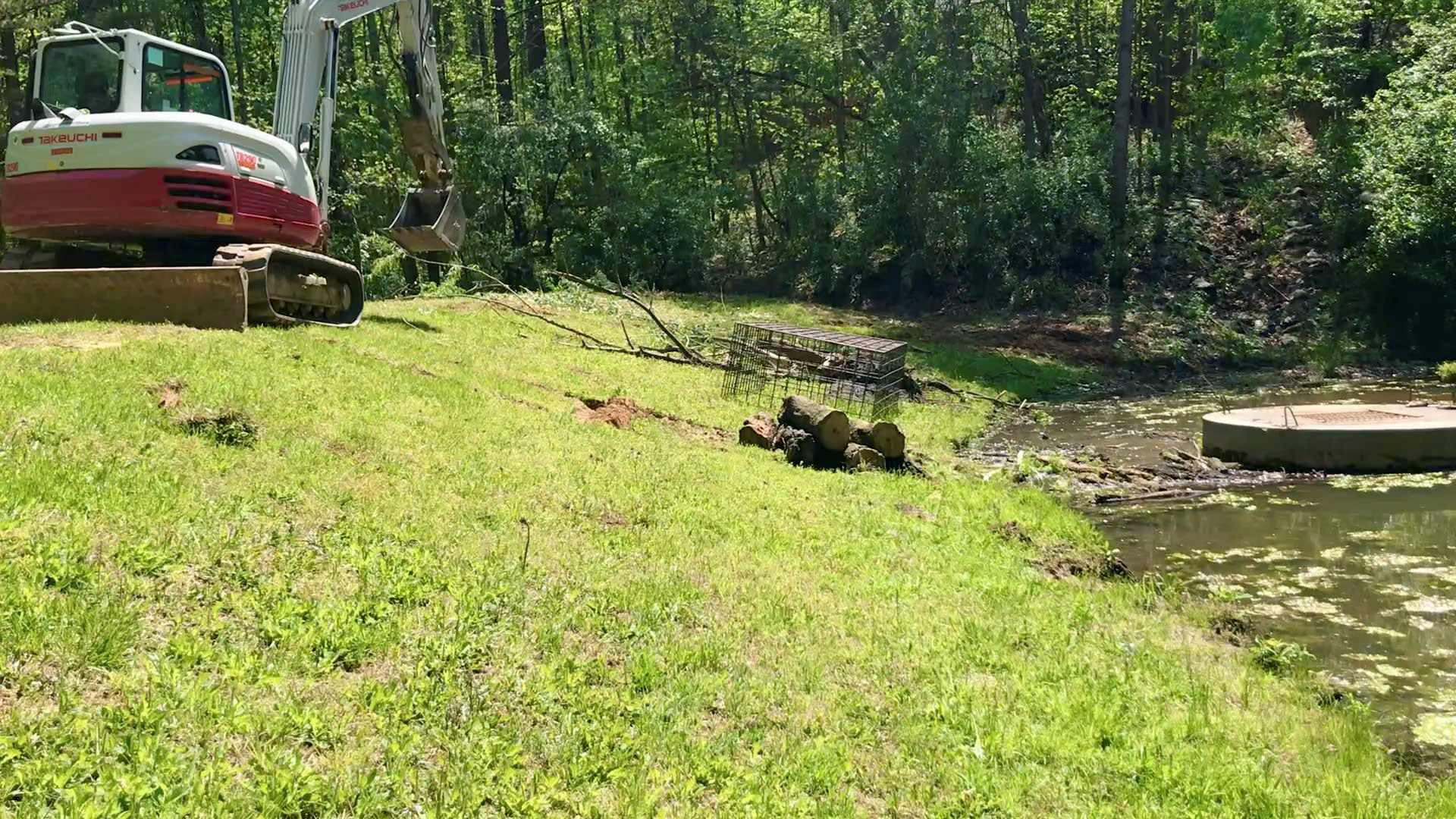
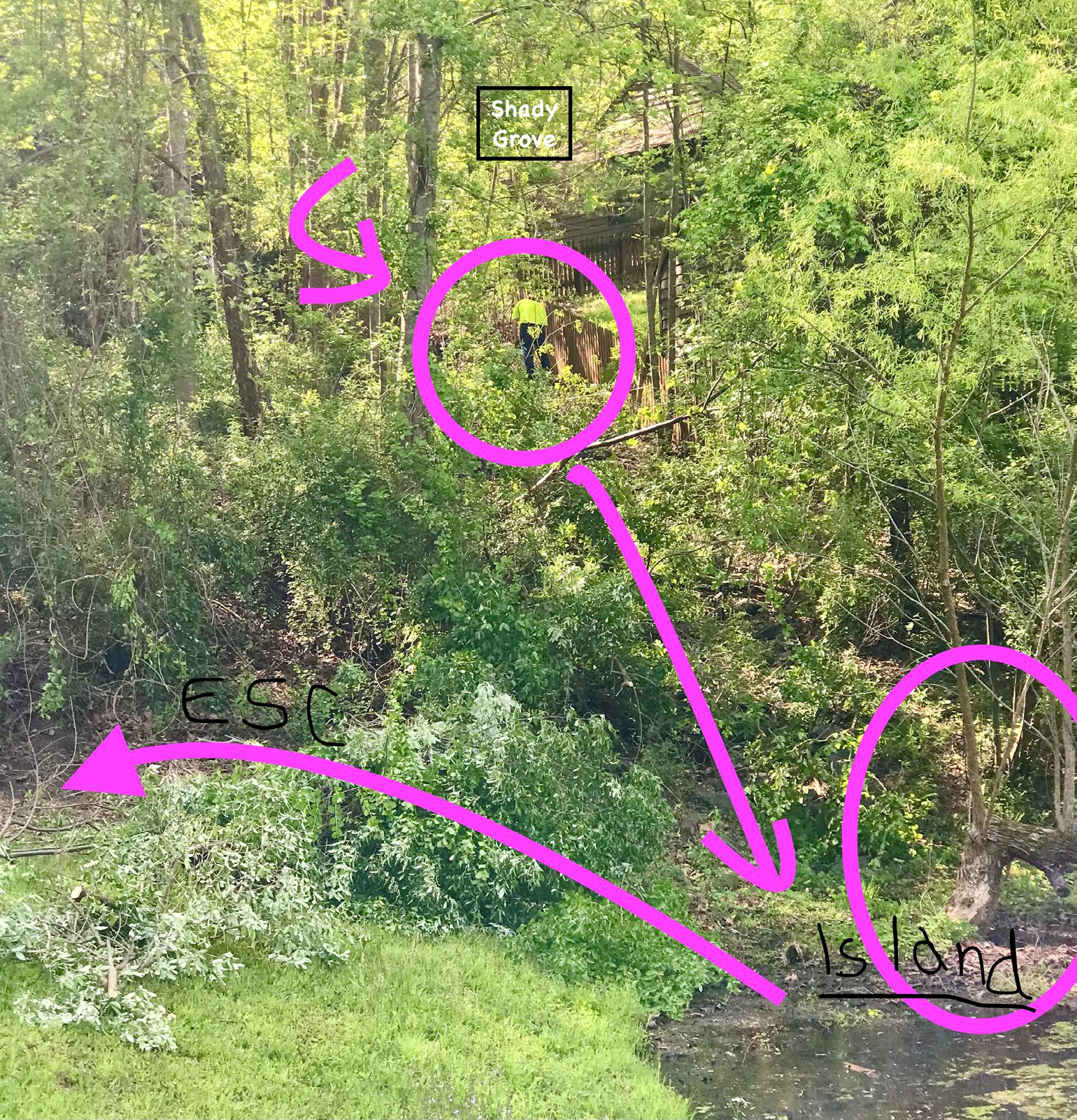
In the above photo, multiple jobs that needed doing can be seen.
The Emergency Spillway Channel (ESC) is being cleared by stormwater management professionals.
Please note that the island and the Shady Grove rock channel termination are both located at the mouth of the ESC potentially blocking it. They needed clearing Logs and debris are removed from the pond.
The trash rack was removed enabling a view down the riser pipe to check for obstructions. The pipe was clear.
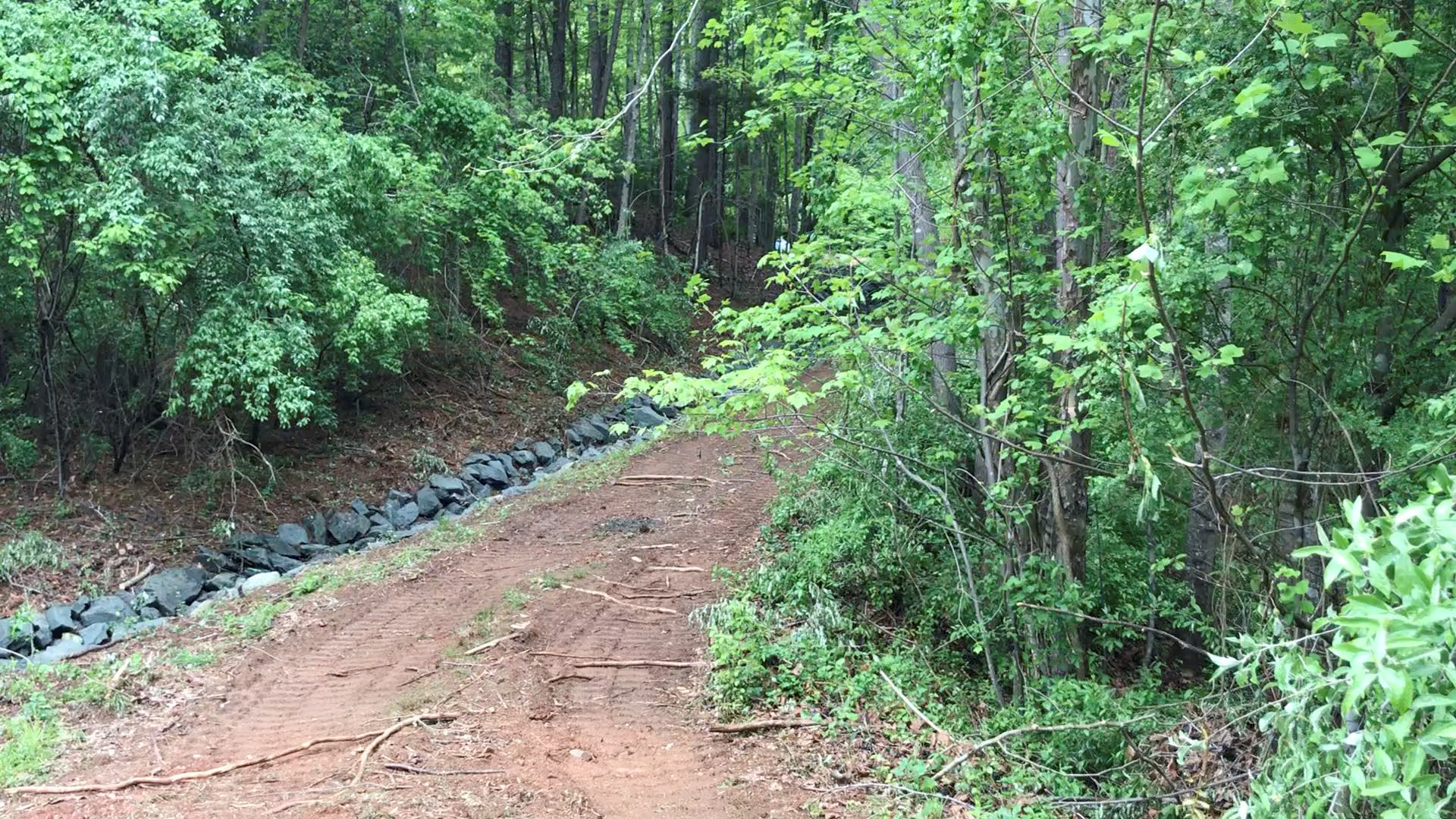
The rock channel from the Arrow Wood Drive cul-de-sac is clear now. The bank on its left has also been cleared back about 15 feet.
The reason clearing is needed is that debris building up in these MCS stormwater management system rock channels will decompose into soil. Then this soil will run down into the pond causing a premature need for dredging. If the pond keeps getting filled up there is not enough room for water to make the system work. We are already working with steep slopes around the pond that can erode more quickly than flat sides. Managing destructive invasive vines on these slopes is in our near future.
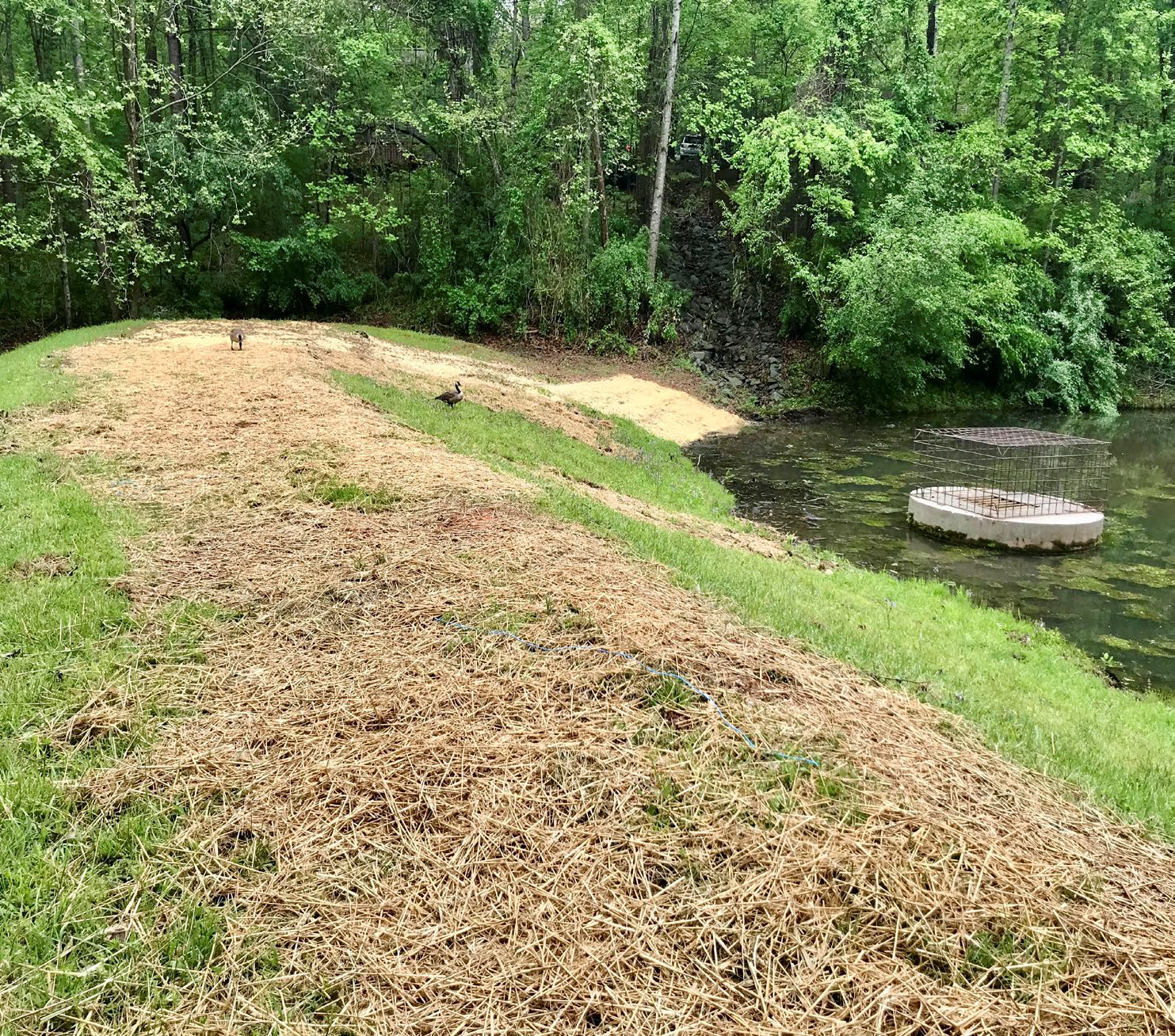

The island is gone and the Shady Grove rock channel is clear. Extra stabilizing straw matting has been laid over the grass seed at the mouth of the Emergency Rock Channel for stability as it grows in, in case of a storm. A storm came two months later.
The total cost to bring the pond into compliance was $6,550.
STAGE II
July 2022.
If we had not done the preventive maintenance prior to the storm of July the 8th, the repair of damage to the dam is estimated to be six figures, as high as $500,000.
Our pond inspector Dave Lockledge wrote us,
“The storm Mill Creek experienced was enormous. Reports are up to 7 inches of rain in 2 hours. NOAA places the frequency at greater than 1000 years for that storm. In addition, the primary spillway was mostly clogged by the trash rack sending most of the water through the emergency spillway. Riprap in the emergency spillway did its job in protecting the earthen dam even though, by the end of the storm, much of it was displaced and water began to top the dam.”
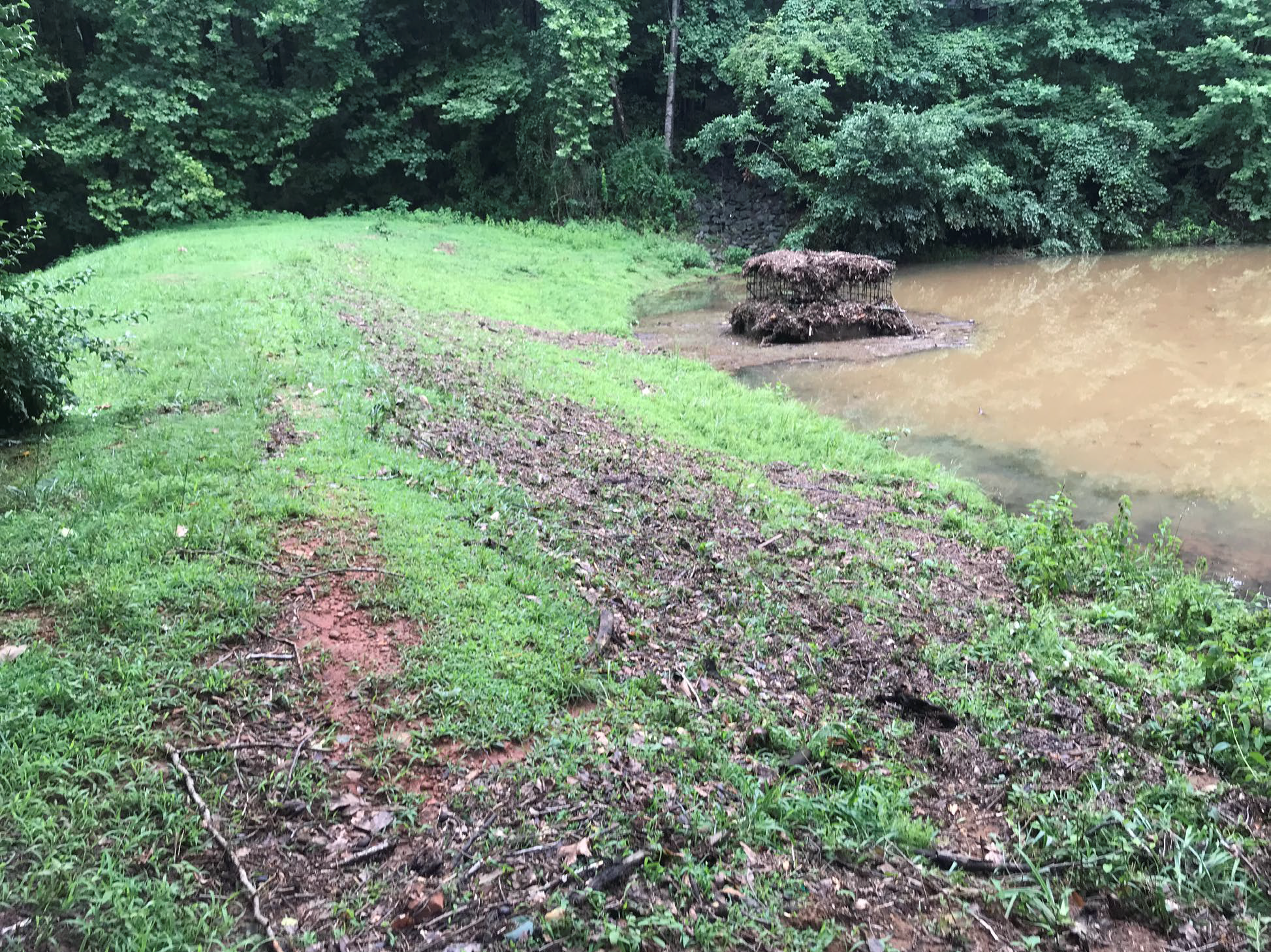
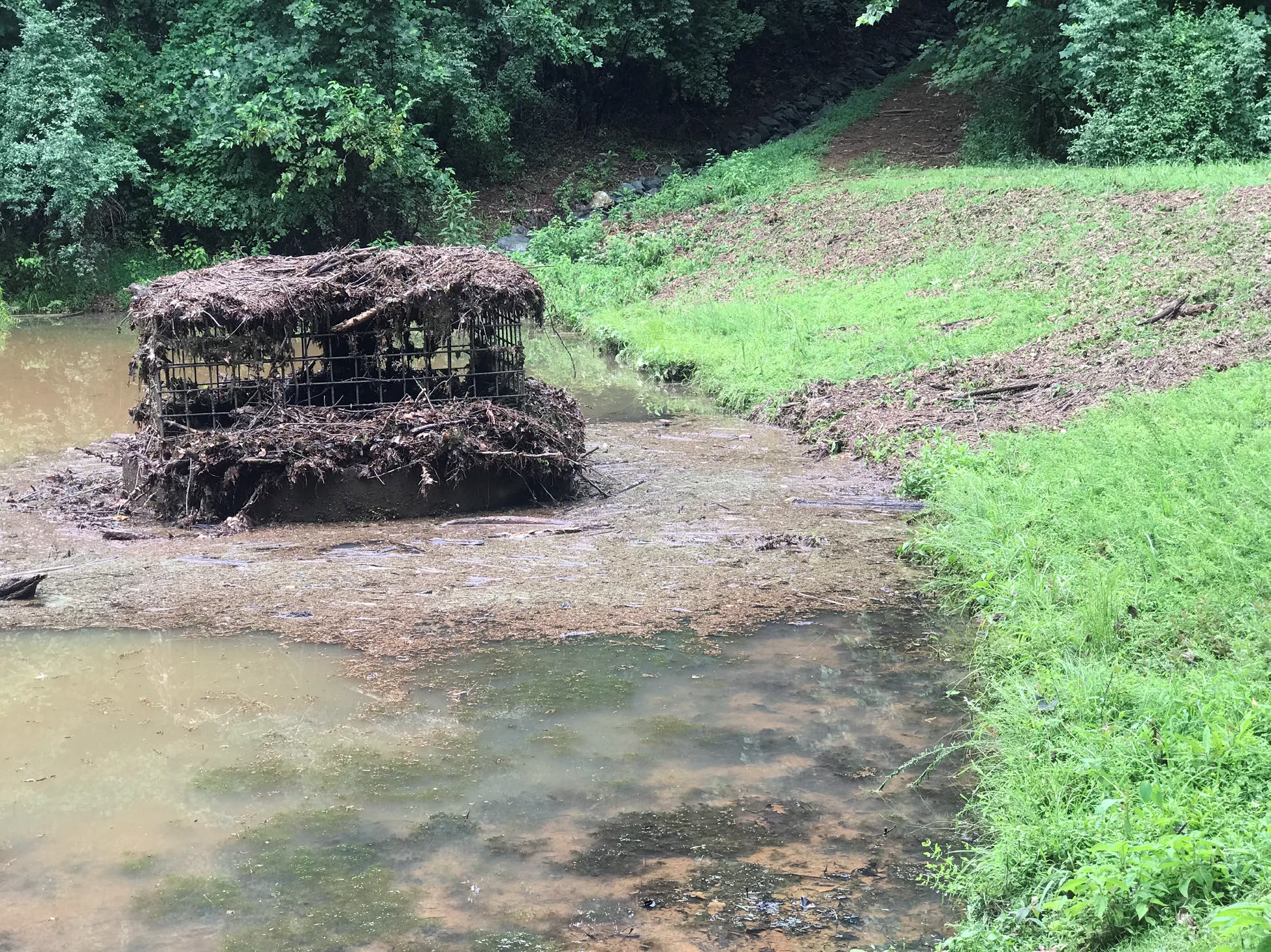
The extreme event storm caused the forest floor debris to wash down the sides of the slopes into the pond and clog the trash rack. This caused the primary pond spillway, the riser pipe above, to clog sending the water to the emergency spillway channel. The emergency spillway channel saved the dam.
However, the 1,000+ year storm finally eroded the channel to bedrock. The riprap was washed down the channel and deposited on the far side of the outlet spill pool.
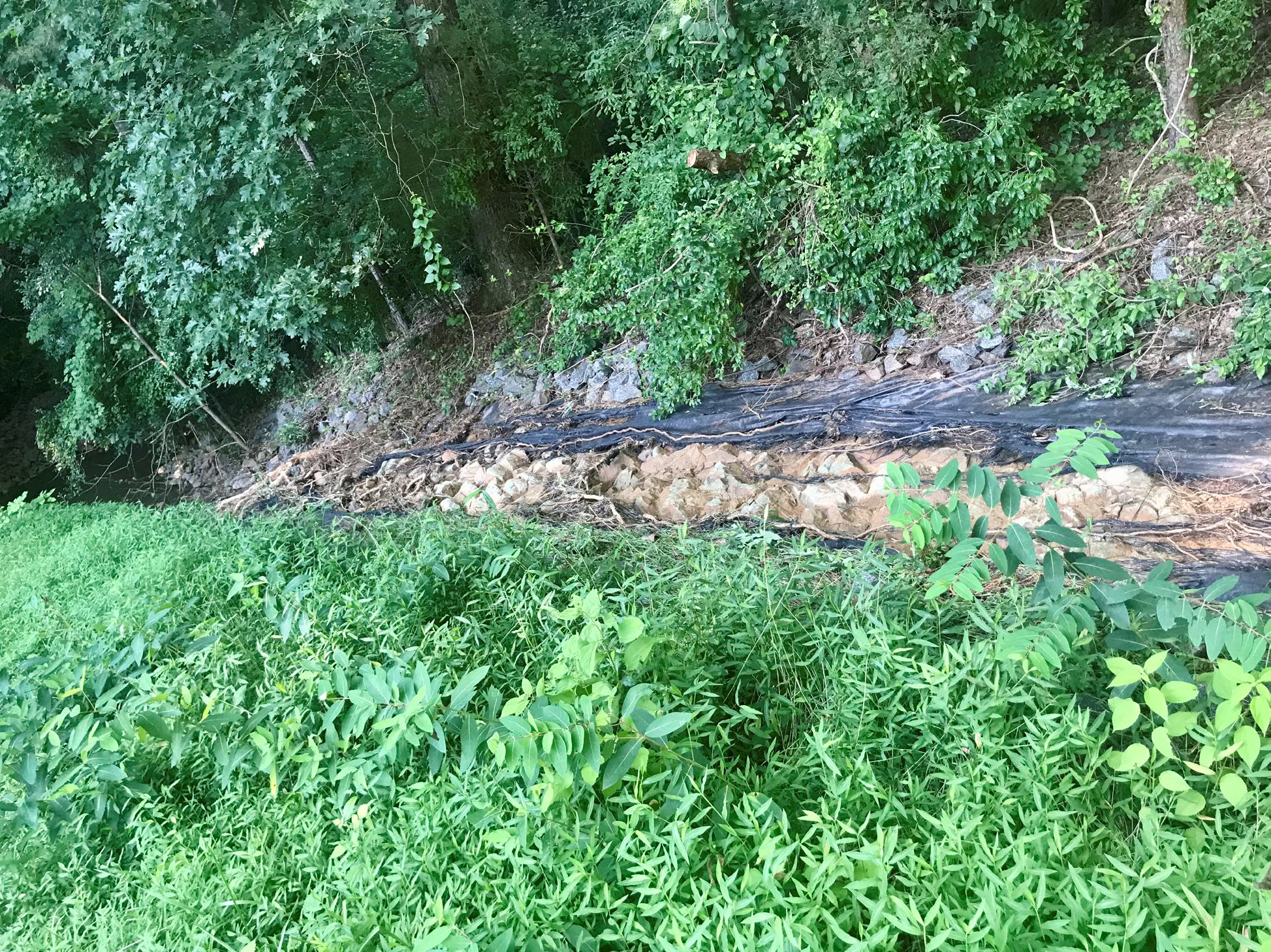
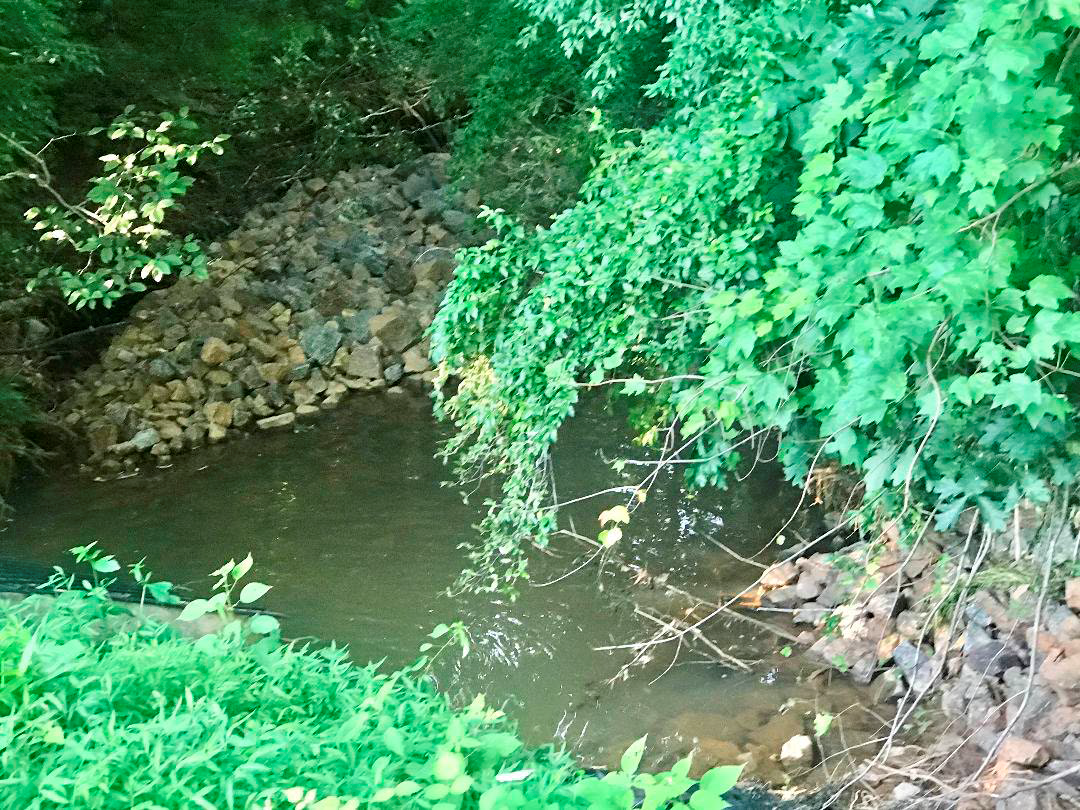
Riprap in a pile at the bottom.
Repairs:
- Emergency Spillway Channel: Handle the rip-rap pile at the bottom, and repair the hole dug at the base in the back of the dam which will threaten the stability of the dam so this needs fixing.
- Silt is building up in the pond and more entered during the storm. Also, some of the forest floor debris leaves, and sticks slid downhill because of the stormwater and entered the pond. Defer the cost and not dredge the pond now for silt, even though some entered the pond during the storm. Right now, it would be very expensive. Wait until later.
- Trash Racks are meant to keep out the branches from entering the riser pipe and clogging it, but allow leaves to pass through. Our trash rack is a rebar cage and it clogged during the storm. Several solutions are being researched. The rebar cage holes may be too small so the leaves clogged them. Or was this storm-related excessive forest floor debris entering the pond? Solution: blowtorch to enlarge the holes which might allow large debris to enter and clog the pipe under the dam. A second solution is recycled plastic trash racks sold by Trash Rax of Virginia and used locally on wet ponds. These are lighter and may have the right size holes, but are more expensive. Everyone wants them because they are lightweight and easy to work with.
The repair strategic sequence looks something like this:
- Clean the trash rack and much of the surrounding debris.
- Move riprap now in a pile at the outlet spill pool to: open a channel; and also stabilize the bank on the west side.
- Emergency Spillway Channel: fill in the hole(s); lay erosion control non-woven matting over the length; then return as much of the rip rap as reasonable, or add new, reasonably larger, jagged-edged rip rap. Mike Wheelwright suggested the extra rip rap have sharp edges because they knit together better, hold better, and slow the water down.
- Riser Pipe and trash rack: What is the best riser pipe trash rack?
Cleanup of Trash rack and debris
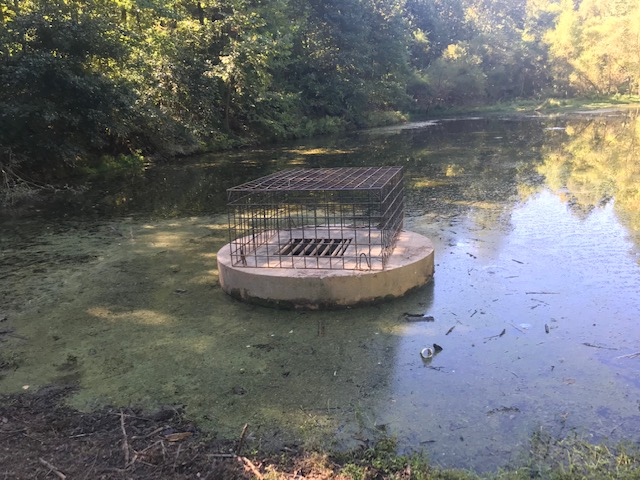
Large Riprap and liner in emergency spillway
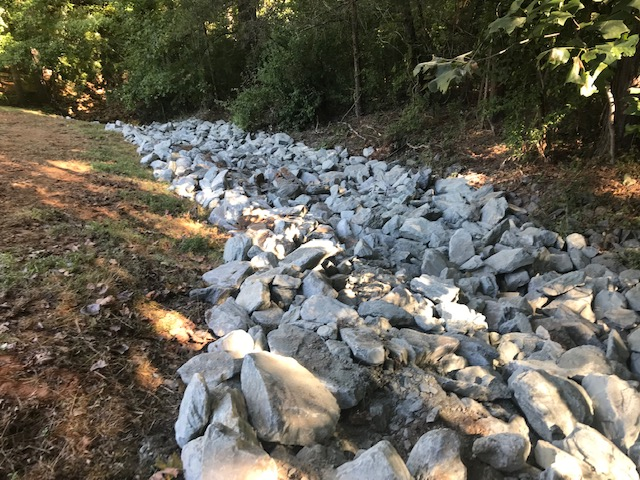
Channel Spillways
Rock-lined channels must have adequately sized riprap to resist displacement and contain an appropriate geotextile fabric or granular filter beneath the rock
Proper design of an open channel spillway will include provisions for minimizing any potential erosion. One way to minimize erosion is to design a flatter channel slope to reduce the velocity of the flow. Earthen channels can be protected by a good grass cover, an appropriately designed rock cover, concrete or various types of erosion control matting. Rock-lined channels must have adequately sized riprap to resist displacement and contain an appropriate geotextile fabric or granular filter beneath the rock
Maintenance
Maintenance should include, but not be limited to, the following items:
Grass-covered channels should be mowed at least twice per year to maintain a good grass cover and to prevent trees, brush and weeds from becoming established. Poor vegetal cover can result in extensive and rapid erosion when the spillway flows. Repairs can be costly. Reseeding and fertilization may be necessary to maintain a vigorous growth of grass.
One suggested seed mixture is 30% Kentucky Bluegrass, 60% Kentucky 31 Fescue, and 10% Perennial Ryegrass.
Trees and brush must be removed from the channel. Tree and brush growth reduces the discharge capacity of the spillway channel. This increases the lake level during large storm events which can lead to overtopping and failure of the dam.
Erosion in the channel must be repaired quickly after it occurs. Erosion can be expected in the spillway channel during high flows, and can also occur because of rainfall and runoff, especially in
areas of poor grass cover. Terraces or drainage channels may be
All obstructions should be kept out of the channel. Open channel spillways often are used for purposes other than passage of flood flows. Among these uses are reservoir access, parking lots, boat ramps, boat storage, pasture and cropland. Permanent structures (buildings, fences, etc.) should not be constructed in these spillways. If fences, bridges or other such structures are absolutely necessary, they should cross the spillway far enough upstream or downstream from the control section so that they do not interfere with the flow Construction of any structures in or across the channel may require prior approval from the State.
Weathering of rock channels can be a serious problem and is primarily due to freeze/thaw action. Deterioration because of sun, wind, rain, chemical action and tree root growth also occurs. Weathered rock is susceptible to erosion and displacement during high flows; therefore, rock channels are often designed with 1 to 3 feet of earth with a grass cover over the rock surface to help insulate the rock from the effects of freeze/thaw action.
Monitoring
Open channel spillways should be monitored for erosion, poor vegetal cover, growth of trees and brush, obstructions, and weathering and displacement of rock. Monitoring should take place on a regular basis and after large flood events. It is important to keep written records of observations. Photographs provide invaluable records of changing conditions. All records should be kept in the operation, maintenance, and inspection manual for the dam.
Dam Ownership Fact Sheet Open channels are often used as the emergency spillway and sometimes as the principal spillway for dams. A principal spillway is used to pass normal inflows, and an emergency spillway is designed to operate only during a large flood. This is necessary in large spillway channels where large amounts of rainfall
and runoff may concentrate and have high velocities. Erosion of the side slopes may deposit material in the spillway channel, especially where the side slopes meet the channel bottom. In small spillways, this can significantly reduce the discharge capacity. This condition often occurs immediately after construction before vegetation becomes established. In these cases, it may be necessary to reshape the channel to provide the necessary capacity.
For dams with pipe conduit principal spillways, an open channel emergency spillway is almost always required as a backup in case the pipe becomes clogged. Open channels are usually located in natural ground adjacent to the dam and can be vegetated, rock lined, or cut in rock. Flow through an emergency spillway does not necessarily indicate a problem with the dam, but high velocity flows can cause severe erosion and result in a permanently lowered lake level if not repaired. Proper design of an open channel spillway will include provisions for minimizing any potential erosion. One way to minimize erosion is to design a flatter channel slope to reduce the velocity of the flow. Earthen channels can be protected by a good grass cover, an appropriately designed rock cover, concrete or various types of erosion control matting. Rock-lined channels must have adequately sized riprap to resist displacement and contain an appropriate geotextile fabric or granular filter beneath the rock. Guide berms are often required to divert flow through open channels away from the dam to prevent erosion of the embankment fill. If an open channel is used for a principal spillway, it must be rock-lined or cut in rock due to more frequent or constant flows. Many States have requirements, based on hazard classification, for how often an earth (grass-lined) or a rock-lined emergency spillway should be used prior to maintenance procedures. It is important to check the guidelines or regulations in your State.
Ongoing Maintenance
Maintenance should include, but not be limited to, the following items: Grass-covered channels should be mowed at least twice per year to maintain a good grass cover and to prevent trees, brush and weeds from becoming established. Poor vegetal cover can result in extensive and rapid erosion when the spillway flows. Repairs can be costly. Reseeding fertilization may be necessary to maintain a vigorous growth of grass. One suggested seed mixture is 30% Kentucky Bluegrass, 60% Kentucky 31 Fescue, and 10% Perennial Ryegrass. Trees and brush must be removed from the channel. Tree and brush growth reduces the discharge capacity of the spillway channel. This increases the lake level during large storm events which can lead to overtopping and failure of the dam. Erosion in the channel must be repaired quickly after it occurs. Erosion can be expected in the spillway channel during high flows, and can also occur because of rainfall and runoff, especially in areas of poor grass cover. Terraces or drainage channels may be necessary in large spillway channels where large amounts of rainfall and runoff may concentrate and have high velocities. Erosion of the side slopes may deposit material in the spillway channel, especially where the side slopes meet the channel bottom. In small spillways, this can significantly reduce the discharge capacity. This condition often occurs immediately after construction before vegetation becomes established. In these cases, it may be necessary to reshape the channel to provide the necessary capacity. All obstructions should be kept out of the channel. Open channel spillways often are used for purposes other than passage of flood flows. Among these uses are reservoir access, parking lots, boat ramps, boat storage, pasture and cropland. Permanent structures (buildings, fences, etc.) should not be constructed in these spillways. If fences, bridges or other such structures are absolutely necessary, they should cross the spillway far enough upstream or downstream from the control section so that they do not interfere with the flow Construction of any structures in or across the channel may require prior approval from the State.
Dam Summary
November 2021- Inspection of Dam
Clogged emergency spillway
Debris in Pond around mail spillway
March 2022 – Pond brought into compliance
Unclogged emergency spillway
Debris removed
Fitch contracted – $6550
July 2022 – Major storm Damage to Dam and spillways
Fitch Contracted – $10,000
October 2022 – Dam surveyed and found in compliance by Albemarle County water resources specialist David Lockledge
| Total spent on repairing the dam | $17,524 |
| Snow Strom Cleanup | $7,000 |
| Extra expenses Incurred | $24,524 |
| Amount in Reserve Account | $30,000 |
| Amount needed to pay taken from reserve | ($10,000) |
| Reserve Account | $20,000 |
All posted at the 2023 Annual Meeting Minutes in March 2023
The board members and 26 home owners attended
Dam Ownership Fact Sheets
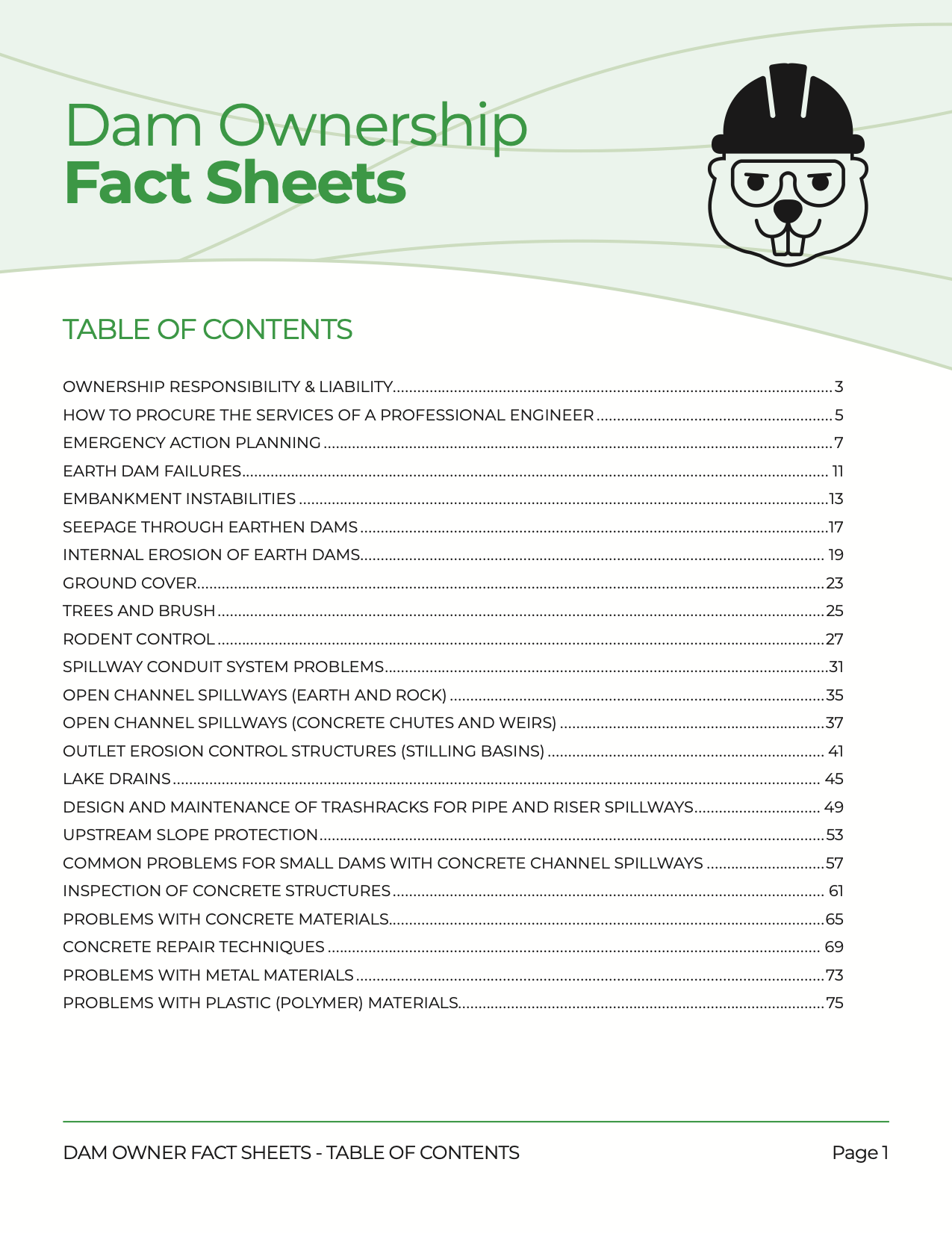
Helpful Sources of information
Albemarle County Wet Retention Pond Inspector:
David Lockledge
Stormwater Specialist
Facilities and Environmental Services
Albemarle County
DLockledge@Albemarle.org
Office: 434-296-5832 x3211
https://damsafety.org/dam-owners
Letter of Compliance
